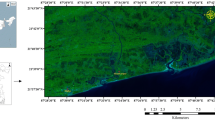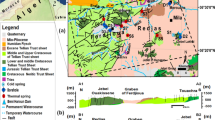Abstract
The Krabi saline hot spring (Khlong Thom Hot Spring) located in southern Thailand has been recognized as a unique geothermal spring attraction due to its high-salinity geothermal groundwater. Studies have been performed to understand the mechanisms of saltwater intrusion into the geothermal aquifers. However, little is known about how the high-salinity groundwater affects the local geological structures, geological materials, and groundwater aquifers. Therefore, we performed integrated geological well measurements, geophysical electrical resistivity tomography (ERT) surveys, and geochemical analyses for major ions (cations and anions) and geothermometers (silica and cation) to investigate the local geological settings and the sources of salinity in the Krabi saline geothermal system. The water samples from the natural hot spring pools and geothermal wells were uniformly of the Cl−-Na+ type with high total dissolved solids (TDS) contents ranging from 12,663 to 15,180 mg/L, but the nongeothermal water was considered to be shallow groundwater of the Na+-HCO3− type with lower TDS contents. Once the trapped saltwater intruded into the wetlands (saltmarshes), its chemical composition was modified by the freshwater/groundwater mixing processes active in the development of shallow geothermal reservoirs. However, a silica-quartz geothermometer was utilized, and the calculated reservoir temperatures ranged from 83 to 86 °C, unlike the cation and silica-chalcedony geothermometers, which were not likely to be applicable for estimating reservoir temperatures in this geothermal system. Moreover, the ion ratios indicated that the water-rock interactions occurring within the geothermal reservoir, mostly related to its nonequilibrium state, might have little effect on the quality of the geothermal groundwater. ERT interpretation was carried out to compare the characteristics of the geological materials obtained directly from the geothermal wells with their apparent resistivity values corresponding to the obtained 2D-ERT profiles. Low resistivity values, ranging from 1 to 10 Ω-m, may have arisen from the dominating influence of the freshly mixed saltwater, which mainly originated via saltwater intrusion into the shallow aquifer on the study site. Therefore, 2D-ERT can be highly useful for detecting changes in thickness and detecting the presence of local faults in the Krabi saline geothermal field. In comparison, geothermal water rose to the surface due to local faults and this finding was well associated with a tectonic junction of the Krabi geological setting. These research findings suggest that governmental agencies should consider combining the results from academic geoscience studies with business objectives to develop a sustainable developmental plan for the geothermal spring attractions of Thailand.
Similar content being viewed by others
References
APHA, AWWA, and WEF, 2017, Standard Methods for the Examination of Water and Wastewater (23rd edition). American Public Health Association, American Water Works Association, Water Environment Federation, Washington, DC.
Arnórsson, S., Gunnlaugsson, E., and Svavarsson, H., 1983, The chemistry of geothermal waters in Iceland. III. Chemical geothermometry in geothermal investigations. Geochimica et Cosmochimica Acta, 47, 567–577.
Attwa, M., Gemail, K.S., and Eleraki, M., 2016, Use of salinity and resistivity measurements to study the coastal aquifer salinization in a semi-arid region: a case study in northeast Nile Delta, Egypt. Environmental Earth Sciences, 75, 1–18.
Batayneh, A.T. and Al-Taani, A.A., 2016, Integrated resistivity and water chemistry for evaluation of groundwater quality of the Gulf of Aqaba coastal area in Saudi Arabia. Geosciences Journal, 20, 403–413.
Çadraku, H.S., 2021, Groundwater quality assessment for irrigation: case study in the Blinaja River Basin, Kosovo. Civil Engineering Journal, 7, 1515–1528.
Cassiani, G., Bruno, V., Villa, A., Fusi, N., and Binley, A.M., 2006, A saline trace test monitored via time-lapse surface electrical resistivity tomography. Journal of Applied Geophysics, 59, 244–259.
Cao, W.G., Yang, H.F., Liu, C.L., Li, Y.J., and Bai, H., 2018, Hydrogeochemical characteristics and evolution of the aquifer systems of Gonghe Basin, northern China. Geoscience Frontiers, 9, 907–916.
D’Amore, F., Giusti, D., and Abdallah, A., 1998, Geochemistry of the high-salinity geothermal field of Asal, Republic of Djibouti, Africa. Geothermics, 27, 197–210.
Duriez, A., Marlin, C., Dotsika, E., Massault, M., Noret, A., and Morel, J.L., 2008, Geochemical evidence of seawater intrusion into a coastal geothermal field of central Greece: example of the Thermopylae system. Environmental Geology, 54, 551–564.
Fournier, R.O., 1977, Chemical geothermometers and mixing models for geothermal systems. Geothermics, 5, 41–50.
Fournier, R.O. and Truesdell, A.H., 1973, An empirical Na−K−Ca geothermometer for natural waters. Geochimica et Cosmochimica Acta, 37, 1255–1275.
Giao, P.H., Chung, S.G., Kim, D.Y., and Tanaka, H., 2003, Electric imaging and laboratory resistivity testing for geotechnical investigation of Pusan clay deposits. Journal of Applied Geophysics, 52, 157–175.
Giggenbach, W.F., 1988, Geothermal solute equilibria. Derivation of Na−K−Mg−Ca geoindicators. Geochimica et Cosmochimica Acta, 52, 2749–2765.
Guo, J., Zhou, X., Wang, L., Zhang, Y., Shen, X., Zhou, H., Ye, S., and Fang, B., 2018, Hydrogeochemical characteristics and sources of salinity of the springs near Wenquanzhen in the eastern Sichuan Basin, China. Hydrogeology Journal, 26, 1137–1151.
Hermans, T., Vandenbohede, A., Lebbe, L., Martin, R., Kemna, A., Beaujean, J., and Nguyen, F., 2012, Imaging artificial salt water infiltration using electrical resistivity tomography constrained by geostatistical data. Journal of Hydrology, 438–439, 168–180.
Kanellopoulos, C., Xenakis, M., Vakalopoulos, P., Kranis, H., Christopoulou, M., and Vougioukalakis, G., 2020, Seawater-dominated, tectonically controlled and volcanic related geothermal systems: the case of the geothermal area in the northwest of the island of Euboea (Evia), Greece. International Journal of Earth Sciences, 109, 2081–2112.
Kanjanapayont, P., Grasemann, B., Edwards, M.A., and Fritz, H., 2012, Quantitative kinematic analysis within the Khlong Marui shear zone, southern Thailand. Journal of Structural Geology, 35, 17–27.
Kanjanapayont, P., 2014, Deformation style of the Mesozoic sedimentary rocks in southern Thailand. Journal of Asian Earth Sciences, 92, 1–9.
La Croix, A.D., Dashtgard, S.E., and MacEachern, J.A., 2019, Using a modern analogue to interpret depositional position in ancient fluvial-tidal channels: example from the McMurray Formation, Canada. Geoscience Frontiers, 10, 2219–2238.
Lee, J.Y. and Song, S.H., 2007, Groundwater chemistry and ionic ratios in a western coastal aquifer of Buan, Korea: implication for seawater intrusion. Geosciences Journal, 11, 259–270.
Magri, F., Akar, T., Gemici, U., and Pekdeger, A., 2012, Numerical investigations of fault-induced seawater circulation in the Seferihisar-Balçova Geothermal system, western Turkey. Hydrogeology Journal, 20, 103–118.
Mao, X., Zhu, D., Ndikubwimana, I., He, Y., and Shi, Z., 2021, The mechanism of high-salinity thermal groundwater in Xinzhou geothermal field, South China: insight from water chemistry and stable isotopes. Journal of Hydrology, 593, 125889. https://doi.org/10.1016/j.jhydrol.2020.125889
Moncada-Aguilar, A.M., Ramírez-Hernández, J., Quintero-Núñez, M., and Avendaño-Reyes, L., 2010, Origin of salinity in groundwater of neighboring villages of the Cerro Prieto geothermal field. Water, Air, & Soil Pollution, 213, 389–400.
Ngansom, W. and Durrast, H., 2016, Saline hot spring in Krabi, Thailand: a unique geothermal system. The SEG International Exposition and 87th Annual Meeting (Expanded Abstract), Dallas, Oct. 16–21, p. 5089–5093. https://doi.org/10.1190/segam2016-13880715.1
Ngansom, W. and Duerrast, H., 2019, Assessment and ranking of hot springs sites representing geothermal resources in southern Thailand using positive attitude factors. Chiang Mai Journal of Science, 46, 592–608.
Ngansom, W. and Duerrast, H., 2021, Geochemical characterization of hot spring waters from southern Thailand as the base for geothermal energy utilization. Environment Asia, 14, 37–49. https://doi.org/10.14456/ea.2021.21
Nieva, D. and Nieva, R., 1987, Developments in geothermal energy in Mexico—part twelve. A cationic geothermometer for prospecting of geothermal resources. Heat Recovery Systems and CHP, 7, 243–258.
Pétré, M.A., Ladouche, B., Seidel, J.L., Hemelsdaël, R., Montety, V., Batiot-Guilhe, C., and Lamotte, C., 2020, Hydraulic and geochemical impact of occasional saltwater intrusions through a submarine spring in a karst and thermal aquifer (Balaruc peninsula near Montpellier, France). Hydrology and Earth System Sciences, 24, 5655–5672.
Petersen, H.I. and Ratanasthien, B., 2011, Coal facies in a Cenozoic paralic lignite bed, Krabi Basin, southern Thailand: changing peat-forming conditions related to relative sea-level controlled water table variations. International Journal of Coal Geology, 87, 2–12.
Polachan, S., Pradidtan, S., Tongtaow, C., Janmaha, S., Intarawijitr, K., and Sangsuwan, C., 1991, Development of Cenozoic basins in Thailand. Marine and Petroleum Geology, 8, 84–97.
Prasetio, R., Daud, Y., Hutabarat, J., and Hendarmawan, H., 2021, Fluid geochemistry and isotope compositions to delineate physical processes in Wayang Windu geothermal reservoir, Indonesia. Geosciences Journal, 25, 507–523.
Ridd, M.F., 2009, The Phuket Terrane: a Late Palaeozoic rift at the margin of Sibumasu. Journal of Asian Earth Sciences, 36, 238–251.
Ridd, M.F., 2012, The role of strike-slip faults in the displacement of the Palaeotethys suture zone in Southeast Thailand. Journal of Asian Earth Sciences, 51, 63–84.
Toumi, A. and Remini, B., 2021, Evaluation of geology and hydrogeology of the water leakage in Hammam-Grouz Dam, Algeria. Journal of Human, Earth, and Future, 2, 269–295.
WHO, 2017, Guidelines for drinking-water quality (4th edition), incorporating the 1st addendum. World Health Organization, Geneva, 631 p.
Acknowledgments
This work was supported by Thailand Science Research and Innovation (TSRI) for the Basic Research Fund & Institutional Capacity Building Fund operated by Ramkhamhaeng University (50151/2021) for funding the research grant.
Author information
Authors and Affiliations
Corresponding author
Additional information
Publisher’s Note Springer Nature remains neutral with regard to jurisdictional claims in published maps and institutional affiliations.
Rights and permissions
About this article
Cite this article
Dürrast, H., Ngansom, W. Integrated geophysical and geochemical investigations on the high-salinity geothermal waters of the Khlong Thom Hot Spring tourist attraction in Krabi, southern Thailand. Geosci J 26, 621–635 (2022). https://doi.org/10.1007/s12303-022-0007-0
Received:
Accepted:
Published:
Issue Date:
DOI: https://doi.org/10.1007/s12303-022-0007-0




